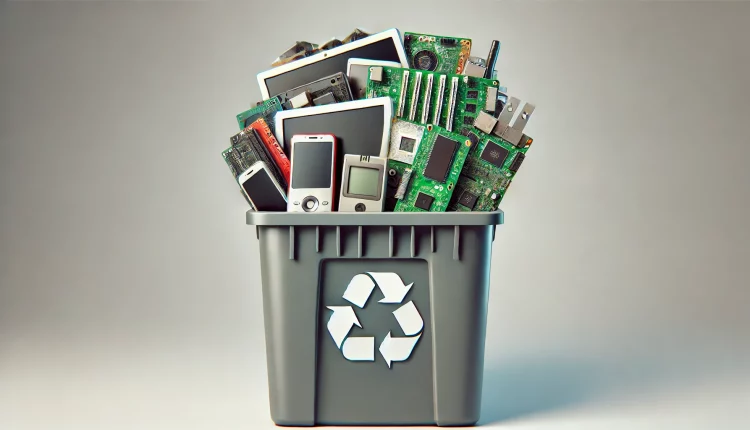- Advertisement -
As our world increasingly depends on electronic devices, the amount of electronic waste, or e-waste, continues to soar. Phones, computers, and other digital devices contribute to an annual global e-waste production exceeding 50 million tons, with much of it improperly disposed of, leaching toxins like lead and mercury into the environment. Unlike conventional waste, e-waste requires specialized recycling due to its complex material composition and toxic components. This article explores the importance of e-waste recycling, methods to do it responsibly, and how we as consumers and businesses can contribute to reducing its environmental impact.
Why E-Waste Recycling Is Critical
E-waste is unique because it often contains valuable metals such as gold, silver, and copper, as well as rare earth elements like neodymium. Recovering these materials through recycling conserves resources and reduces the need for environmentally harmful mining activities. However, e-waste is also laden with hazardous materials that, if discarded in landfills, can leach into soil and water, contaminating ecosystems and posing health risks to nearby communities.
Effective e-waste recycling extracts valuable components, responsibly disposes of toxins, and ensures that re-usable parts can be re-purposed, supporting a circular economy.
Current Challenges in E-Waste Recycling
Despite the potential benefits, the global e-waste recycling rate remains around 20%. Here are some of the primary barriers to efficient e-waste recycling:
- Complex Design of Electronics: Modern electronics are composed of numerous materials tightly integrated within compact designs, making it difficult to separate recyclable components.
- Lack of Awareness and Infrastructure: Many consumers are unaware of how or where to recycle e-waste, and in some areas, there are few facilities equipped to handle it.
- Economic Constraints: Recycling e-waste can be more costly than disposing of it, as specialized technology and skilled labor are required. Thus, without adequate incentives, manufacturers may not engage in responsible recycling.
- Illegal Exports: Some countries lack stringent e-waste regulations, leading to illegal exports of e-waste to developing nations, where unregulated disposal or informal recycling can expose workers to health hazards.
Methods for Proper E-Waste Recycling
Effective e-waste recycling can be achieved through a mix of policies, infrastructure development, and consumer participation. Here are key steps to proper e-waste disposal:
- Certified E-Waste Recyclers: Look for recyclers who are certified to handle e-waste responsibly, as they adhere to guidelines that ensure safe material extraction and disposal practices.
- Return Programs: Many manufacturers and retailers offer take-back programs where customers can return their old devices. These programs are often free and ensure that devices are processed correctly.
- Repair and Refurbish: Extending the life of electronics through repair or donating them for refurbishing can significantly reduce e-waste. Some businesses and charities accept functioning or minimally damaged electronics for reuse.
- Community Collection Events: Municipalities and NGOs often host e-waste collection events, making it convenient for people to dispose of electronics safely.
Innovations in E-Waste Recycling
New technology is evolving to make e-waste recycling more efficient:
- Robotics and Automation: Robotics can disassemble complex electronic devices faster and more precisely than human labor, reducing recycling costs.
- Chemical Recycling: Some recyclers are experimenting with chemical solvents to extract rare earth elements, metals, and other valuable materials from electronics with minimal waste.
- AI Sorting Systems: Artificial intelligence can identify and sort various e-waste materials, streamlining the recycling process and ensuring that recyclable components are not missed.
The Role of Governments and Corporations
Legislation, consumer awareness campaigns, and corporate responsibility all play a crucial role in managing e-waste:
- Extended Producer Responsibility (EPR): Some governments have implemented EPR policies that require manufacturers to manage their products’ end-of-life recycling. This encourages companies to design products with easier recycling in mind.
- Right to Repair Laws: Right to repair laws support consumers’ ability to repair devices, potentially reducing e-waste by extending product life. When implemented, these laws allow access to parts and information, encouraging more repair rather than replacement.
- Consumer Awareness: Educational campaigns can make consumers more mindful of the lifespan of their electronics and the impact of e-waste. Such awareness often encourages responsible disposal practices.
Consumer Tips for Reducing E-Waste
While e-waste recycling is crucial, minimizing e-waste production is equally important. Here are practical steps:
- Opt for Quality Over Quantity: Investing in high-quality devices that last longer is a proactive way to reduce e-waste.
- Prioritize Repair: Before replacing a malfunctioning device, consider repair options. Many issues can be fixed with minimal cost or effort.
- Donate and Reuse: If you no longer need a device, consider donating it or selling it second-hand. Many charities and organizations accept electronics, especially if they are in good working condition.
Conclusion
E-waste recycling is not just an environmental necessity but an opportunity to recover valuable resources and protect our planet from toxic waste. By responsibly managing our electronic devices, embracing innovations in recycling, and advocating for stronger regulations, we can contribute to a sustainable, circular economy. Each piece of e-waste diverted from landfills represents a step toward a cleaner, greener future.

